Online proceedings
*Notice: PDF files are protected by password, please input "ipop2011.7th". Thank you.
Thursday 2, June 2011
- Bijan Jabbari, General Co-chair, ISOCORE, USA

Cloud is moving to next step for the human-friendly information society. For such forthcoming cloud era, communications must become richer, more reliable, and more responsive, which enable any users to make innovations. This talk reviews the ICT evolution in computer, wireless, and optical network technologies, and then provide a new R&D direction (Symbiosis, Dependable, and Ecology) for the future ICT. One key factor in this direction is software-definable feature, like flow-based control in the packet networks. I would like to raise a question to iPOP, "what way do we go for software-definable optical networks?"
Biography: Toshiyuki Kanoh joined NEC Corporation in 1981. He worked in the field of Telecommunication system and LSI development, and then he directed the development of IP switch/router system and Next-generation communication system as Senior Manager. He is directing R&D of the system platforms for Optical network, OpenFlow, Future Internet, Wireless access, Cloud computing and Green ICT, and is currently General Manager of System Platforms Research Labs, NEC Corporation.

This talk will contain an introduction to MPLS-TP, how it related to IP/MPLS, MPLS-TP deployment scenarios, its standardization status, and MPLS-TP multivendor interoperability testing to date.
Biography: Andrew G. Malis holds the Director-level position of Principal Member of the Technical Staff at Verizon Communications. He has been active in wide-area data networking and telecommunications for over 35 years, beginning with the ARPANET, the foundation of today's Internet. He has also held senior engineering positions at Bolt, Beranek, and Newman; Ascom Nexion; Cascade Communications; Ascend Communications; Lucent Technologies; Vivace Networks; and Tellabs. His current responsibilities include Verizon's packet network architecture and evolution, future network planning, standards participation, and vendor and customer consultation.
He is also on the board and Vice President of the Broadband Forum, co-chairs the Internet Engineering Task Force's (IETF's) Pseudowire Emulation Edge to Edge (PWE3) Working Group, was President and Chairman of the Board of the IP/MPLS Forum, has been a member of the IETF's Internet Architecture Board (IAB), has served on the board of the IPsphere Forum, and is a veteran participant and award recipient in other standards bodies and industry consortia. He has written, edited, and otherwise contributed to many standards documents in these organizations, including more than 30 IETF RFCs. He has also served on the technical advisory boards of several privately held high-tech companies, has chaired and spoken at numerous industry conferences, and written journal and magazine articles. He received his Bachelor of Science degree in Computer Science and Applied Mathematics at Brown University, and his Master of Science degree, also in Computer Science and Applied Mathematics, at Harvard University.

Biography: He is the Executive Manager of Broadband Network Systems Project in NTT Network Service Systems Laboratories. He received B.E. and M.E. degrees in Applied Physics, the University of Tokyo, Japan, in 1984 and 1986, respectively. Since joining Nippon Telegraph and Telephone Corporation in 1986, he has been working on innovative technologies such as adaptive ATM traffic control using neural networks and WDM/SCM photonic switching systems. From 2004 to 2008, he worked in the NGN Promotion Office, promoting R&D activities and a field trial for NGN. Currently he focuses on the future packet transport network technologies, including optical packet switching, multi-layer optical network control & management, network virtualization.
He was a visiting associate with Electrical Engineering Dept., Caltech, USA, in 1991-1992. He received the best paper award from the Institute of Electronics, Information and Communication Engineers (IEICE) in 1989.
 Last year, at iPOP 2010, a famous keynotes speaker pointed out some of the reasons why GMPLS is not widely deployed. One of them was operational hurdles for operators. This talk will start from that fact and will focus on the operators' point of view on control plane in transmission networks and associated mechanisms. Several adavantages and drawbacks contributing to carriers' decisions will be highlighted and some preconceived ideas will be ruled out. Some means to progress towards deployments will be discussed, introducing what transmission people currently see in GMPLS. In the end, a technical example, directly extracted from our testbeds, will illustrate an IP + Optical use case, leveraging the control planes in both layers.
Last year, at iPOP 2010, a famous keynotes speaker pointed out some of the reasons why GMPLS is not widely deployed. One of them was operational hurdles for operators. This talk will start from that fact and will focus on the operators' point of view on control plane in transmission networks and associated mechanisms. Several adavantages and drawbacks contributing to carriers' decisions will be highlighted and some preconceived ideas will be ruled out. Some means to progress towards deployments will be discussed, introducing what transmission people currently see in GMPLS. In the end, a technical example, directly extracted from our testbeds, will illustrate an IP + Optical use case, leveraging the control planes in both layers.
Biography: Julien Meuric is graduated from the French engineering school "Ecole Nationale Superieure des Sciences Appliquees et de Technologie". After various activities on packet networks, he has worked since 2004 in the Research and Development division of France Telecom, and more specifically on metropolitan and optical core networks. He is mainly focused on control plane integration in transmission networks, such as SDH or WDM, and interactions with packet layers. As a Standardisation Senior Manager he contributes to coordinate the standardisation of transport network technologies and is personally involved in standardisation around GMPLS control protocols in corresponding IETF working groups (CCAMP, L1VPN, MPLS...). Besides technical contributions, he also acts in IETF as co-chairman of the Path Computation Element (PCE) working group.

Biography: Dr. Masanobu Fujioka is Vice President & Chief Technology Officer, Nippon Ericsson since Feb. 2005. He joined Nippon Ericsson in 1988 to work with IMT-2000 Product Management. From 2003 to 2005, he was Director New Business and Technology regarding new business development and R&D in the new technology areas. From 1978 to 1998, he worked in KDD. He was research engineer in the R&D Labs. until 1983, when he did research on network technology. Then he moved to the Switching Systems Engineering Dept. as Senior Manager, where he managed the development of new service systems. He obtained Ph.D from Osaka University in 1997.

Biography: Shunji YOSHIYAMA received his B.E. degree in electrical engineering from Keio University in 1986. He joined NEC Corporation in 1986 and worked in the field of optical transport system development. And he is now a Senior Manager of the Optical Network Division and in charge of product planning of next generation optical transport system.
 This presentation focuses on so-called router offloading networks for increasing traffic, and addresses its technical challenges and directions toward these challenges.
This presentation focuses on so-called router offloading networks for increasing traffic, and addresses its technical challenges and directions toward these challenges.
Network traffic is ever-increasing. In Japan, internet traffic increases 1.2 - 1.4 times every year. This will increase network cost as well as power consumption. It is estimated that power consumption of network equipments to support such huge traffic will increase 13 times in year 2025 from 2006. How to handle such volume of traffic is a critical issue for many carriers.
It is often said that so-called router offloading networks can be a solution for increasing traffic. In router offloading networks, IP packets from the ingress IP edge router to the egress IP edge router are transmitted at the transport layer rather than IP layer as much as possible, since cost per bit is cheap in transport layer than IP layer. In other words, IP packets are bypassed by transport paths (e.g., wavelength paths, ODU paths, MPLS-TP paths) and directly sent from the ingress IP edge router to the egress IP edge router.
However, there are several technical challenges to realize router offloading networks. The first challenge is scalability and convergence time at the IP edge router. The ingress IP edge router forwards a IP packet to the egress IP edge router through one of transport paths. IP routing protocols (OSPF, BGP etc.) are used at the IP edge routers for making this decision. The number of neighbors in IP layer is quite large in router offloading networks. If there are N IP edge routers, the number of neighbors in IP layer is N-1 for each IP edge router, provided that full-mesh transport paths are established. There is a scalability concern in IP routing. Convergence time may increase in router offloading networks when an IP edge router is in failure or under maintenance.
The second challenge is network planning. In router offloading networks, transport paths between IP edge routers need to be augmented when traffic increases. This means that fine-grained traffic engineering is needed. Operators need to consider where to add capacity by edge IP router-to-edge IP router basis (order of N square), rather than by IP router-to-IP router basis (order of N). Such fine-grained traffic engineering may help to reduce CAPEX by optimized capacity, but increases operational complexity.
In this presentation, relevant technical areas are presented toward such challenges. For challenges concerning scalability and convergence time at the IP edge router, various techniques to improve BGP convergence time are under development, such as BGP add-path, BGP external best. This presentation further proposes server-based route selection for improving scalability of route distribution, and for differentiated recovery grade as future direction.
For challenges concerning network planning, network planning tools are important. Especially, when an IP network is migrating to router offloading network, operators need to decide when and where the bypass transport paths need to be established. For this purpose, operators need to understand edge IP router-to-edge IP router traffic matrix, and how much gain the bypass transport path would give. Furthermore, when a bypass transport path is established, operators need to change routing polices for the modified topology. Related techniques, such as traffic matrix estimation, route simulation are presented.
Biography: Tomonori Takeda received the B.E. and M.E. degrees from Waseda University, Tokyo. Currently, he is with NTT Network Service Systems Laboratories, where his work is focused on R&D on future transport networks. He has been involved in standardization activities, and co-chaired the Layer 1 Virtual Private Network (L1VPN) working group in the IETF (2005-2009).
 This paper proposes a wavelength assignment design scheme for an optical carrier reusable ring
network based on optical carrier reuse technique. This network consists of one regional node and edge
nodes, as shown in Fig. 1. In the regional node, a multi-carrier light source, which has ability to generates a
large number of carrier wavelengths (e.g. more than 10000 carrier wavelengths) at a time, is employed as a
communication light source. Besides, in order to utilize the multi-carrier light source, only the regional node
has the multi-carrier light source, and all edge nodes share it. Besides, for the purpose of improving
wavelength usage efficiency, optical carrier reuse technique is introduced in each edge node. This technique
allows the multiple reuse of optical carriers that were used for data transmission between prior source and
destination nodes.
This paper proposes a wavelength assignment design scheme for an optical carrier reusable ring
network based on optical carrier reuse technique. This network consists of one regional node and edge
nodes, as shown in Fig. 1. In the regional node, a multi-carrier light source, which has ability to generates a
large number of carrier wavelengths (e.g. more than 10000 carrier wavelengths) at a time, is employed as a
communication light source. Besides, in order to utilize the multi-carrier light source, only the regional node
has the multi-carrier light source, and all edge nodes share it. Besides, for the purpose of improving
wavelength usage efficiency, optical carrier reuse technique is introduced in each edge node. This technique
allows the multiple reuse of optical carriers that were used for data transmission between prior source and
destination nodes.
Optical channel establishment is conducted in the following way. When an optical channel establishment request arrives at a source node, the source node drops, i.e., extracts an optical carrier from the network, and transmits data toward its destination node after optical carrier modulation by its external modulator. At this time, this modulated data is added, i.e., inserted into the network, and reaches to the destination node. These drop and add functions are achieved by an optical add-drop multiplexer. After receiving data, the destination node extracts the optical carrier from data signal by our developed optical carrier reuse technique, and reuses it for data transmission as shown in Fig 2. In this way, the carrier regeneration technique reduces the required number of wavelengths used for optical channel establishment, compared to the network without optical carrier reuse function.
In order to establish optical channels with smaller number of carrier wavelengths, a wavelength assignment design scheme that minimizes the number of wavelengths used for optical carrier establishment is developed. As results, two points are observed. First, optical carrier reuse reduces the number of wavelengths for optical channel establishment by 60%, compared to that without carrier reuse. Second, results indicates that reusing optical carriers two times per wavelength is sufficient to realize 60% wavelength reduction.
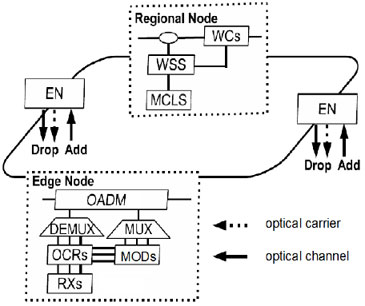
Fig. 1: Network architecture. Edge node (EN) consists of multiplexer (MUX)/demultiplexer (DEMUX), optical carrier regenerators (OCR), external modulators (MOD), and receivers (RX). Regional nodes (RN) consists of multi-carrier light source (MCLS), wavelength selective switch (WSS), wavelength convertors (WCs), optical add-drop multiplexer (OADM).
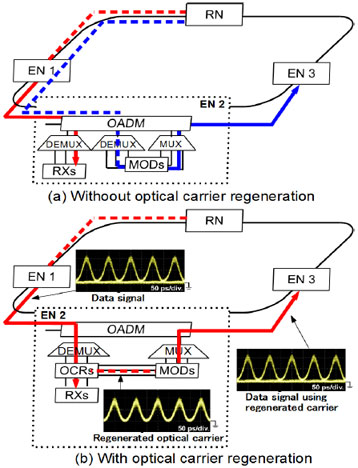
Fig. 2: Wavelengths reduction by optical carrier reuse. Two optical channels are established. Two wavelengths are required in the absence of OCRs, as shown in Fig 2(a), while only one wavelength is needed if each edge node has its OCR, as shown in Fig. 2(b). In Fig 2(b), First channel uses optical carrier generated from the MCLS in the RN, while the second one is established by using reused optical carrier at EN 2.
Biography: Masafumi Keri is with the Information and Communications Department, the University of Electro-Communications, Tokyo Japan. His research focuses on optical networking, optical burst switching, and optical signal processing.
 Many service providers have started to provide real time multicast services such as IP TV to their customers. Because of these real time services, it is very critical now for service providers to provide satisfied continuous services to their customers. Thus the service providers need to keep their services from end-to-end always on. One possible solution for this is to establish two global MPLS TE P2MP LSPs, each of which is from an ingress node to a number of egress nodes, and let these two LSPs carry the customer traffic at the same time. Even though double global LSPs are used, the customer traffic interruption time may not be short enough when some failure such as the ingress node failure happens.
Many service providers have started to provide real time multicast services such as IP TV to their customers. Because of these real time services, it is very critical now for service providers to provide satisfied continuous services to their customers. Thus the service providers need to keep their services from end-to-end always on. One possible solution for this is to establish two global MPLS TE P2MP LSPs, each of which is from an ingress node to a number of egress nodes, and let these two LSPs carry the customer traffic at the same time. Even though double global LSPs are used, the customer traffic interruption time may not be short enough when some failure such as the ingress node failure happens.
In this presentation, we describe a new end-to-end MPLS TE P2MP LSP protection method after analysing the existing solutions for the MPLS TE P2MP LSP protections. The new method protects every part of the P2MP LSP locally; especially it protects the ingress node and every egress node of the P2MP LSP locally. We also illustrate the following advantages of the new protection method through comparing it with the existing solutions:
- Faster recovery. Traffic recovery is within 50ms when any failure including an ingress node failure happens
- Huge saving on network resource such as bandwidth usage. Only one MPLS TE P2MP LSP from the ingress node to the egress nodes is established; there is no need to reserve/use double bandwidth.
- Easier to operate.
In addition, we propose PCE extensions for supporting the new protection method.
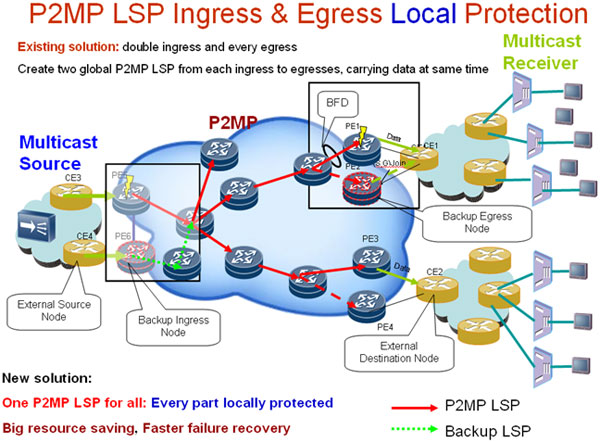
Fig1. P2MP LSP locally & Egress Local Protection.
Biography: Dr. Chen received his B.E. in Computer Technology and Application in 1982, M.E. and Ph.D. in Computer Science in 1987 from CIT and in1998 from University of Victoria respectively.
He has worked on routing and MPLS for about fifteen years in North America from architecture, design, coding and support. He joined Huawei USA in 2006. Recently he is a leader for both PCE P2MP project and MPLS TE P2MP project in Huawei. As a leader and also an engineer, he contributed a lot to the standardization and the delivery of the projects.
He was a university teacher and researcher for quite a few years. In addition to giving several courses and supervising students, he published a book, designed and implemented a couple of computer language systems which are two times faster and eight times more efficient in memory usage than the existing systems during that time.
 We propose a slot-switching based all-optical network to support various network services.
Aggregating various types of networks (e.g., access networks for residential users, leased lines for
business users, mobile backhauls, and fibre channels for data centers) in a single network is
discussed as a candidate of next generation access network. Fig. 1 shows the concept of this
network. There are virtual OLTs (Optical Line Terminals) in a solitary programmable OLT and each
of them provides different services at respective protocols. By integrating network equipments, this
network reduces energy consumption drastically. It also facilitates the introduction of new network
services which use their own protocols.
We propose a slot-switching based all-optical network to support various network services.
Aggregating various types of networks (e.g., access networks for residential users, leased lines for
business users, mobile backhauls, and fibre channels for data centers) in a single network is
discussed as a candidate of next generation access network. Fig. 1 shows the concept of this
network. There are virtual OLTs (Optical Line Terminals) in a solitary programmable OLT and each
of them provides different services at respective protocols. By integrating network equipments, this
network reduces energy consumption drastically. It also facilitates the introduction of new network
services which use their own protocols.
The simplest way to realize this network is using WDM (Wavelength Division Multiplexing) and allocating each wavelength to each network service. However, this method has low scalability because the number of wavelengths that are able to multiplex in a single fiber is limited. In addition, CAPEX (CAPital EXpenditure) becomes high because it is necessary to develop various types of transceivers that adapt different wavelengths respectively.
Our proposed network is an expansion of Active Optical access Network (ActiON) that we have proposed earlier, and uses high-speed optical switches. As shown in Fig. 2, this network has capability to transfer any data signal formats transparently in a single wavelength. The bandwidth is shared by all users and dynamically allocated by fixed-length time slots. In this presentation, we mainly discuss the network architecture.
Acknowledgement: This work was supported by the Japan Society for the Promotion of Science's (JSPS) Grant-in-aid for Scientific Research (C)22500068.
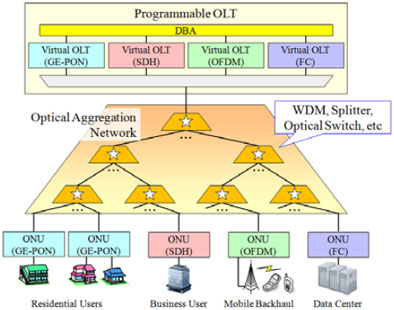
Fig1. The concept of service aggregation network.

Fig2. An image of data transfer.
Biography: Takehiro Sato received his B.E. degree from Keio University, Japan, in 2010. Currently, he is a second-year master's degree student at Keio University. He engages in research on network architecture design and survivability of the next generation optical network. He is a student member of the Institute of Electronics, Information and Communication Engineers (IEICE) of Japan.
 In optical packet switched networks, wavelength conversion is widely used to avoid contention.
A signal with one wavelength is converted to another wavelength. The wavelength of the packet that loses
the contention at the output is converted into an available wavelength and switched to the same output
fiber. A parametric wavelength converter (PWC) is an alternative approach for wavelength conversion
because multiple wavelengths, multi-channels, can be converted simultaneously. To define both the
original wavelength, λw, requiring conversion, and the new wavelength, λw', continuous pump wavelength,
λp, is set as λp = (λw + λw')/2. Therefore, the selection of λp defines the conversion pairs of λw and λw'.
Multiple wavelength conversion based on the parametric process is becoming feasible. A number of
simultaneous multiple wavelengths conversion experiments with over 30 channels have been reported.
There are two pump wavelengths assignment policies, number rich (NR) and variety rich (VR). In NR, all
PWCs have the same pump wavelength, generated by a laser diode (LD), and placed at the center of the
transmission wavelengths. In VR, the different pump wavelengths, generated by several LDs, are set
close to the center of the transmission wavelengths. Although NR needs only one light source for PWCs,
while VR needs it as many as the number of PWCs, it has a higher packet loss rate than VR.
In optical packet switched networks, wavelength conversion is widely used to avoid contention.
A signal with one wavelength is converted to another wavelength. The wavelength of the packet that loses
the contention at the output is converted into an available wavelength and switched to the same output
fiber. A parametric wavelength converter (PWC) is an alternative approach for wavelength conversion
because multiple wavelengths, multi-channels, can be converted simultaneously. To define both the
original wavelength, λw, requiring conversion, and the new wavelength, λw', continuous pump wavelength,
λp, is set as λp = (λw + λw')/2. Therefore, the selection of λp defines the conversion pairs of λw and λw'.
Multiple wavelength conversion based on the parametric process is becoming feasible. A number of
simultaneous multiple wavelengths conversion experiments with over 30 channels have been reported.
There are two pump wavelengths assignment policies, number rich (NR) and variety rich (VR). In NR, all
PWCs have the same pump wavelength, generated by a laser diode (LD), and placed at the center of the
transmission wavelengths. In VR, the different pump wavelengths, generated by several LDs, are set
close to the center of the transmission wavelengths. Although NR needs only one light source for PWCs,
while VR needs it as many as the number of PWCs, it has a higher packet loss rate than VR.
This paper presents a hybrid pump wavelength assignment (HPA) scheme that combines the advantages of NR, requiring fewer light sources, and VR, lower packet loss rate then NR. HPA, as shown in Fig. 1, provides a cost-effective way by minimizing the number of different colored light sources. PWCs are separated into two sets. In the first set, PWC pump wavelengths are assigned according to the NR policy, called NR-based PWCs. In the second set, PWC pump wavelengths are assigned according to the VR policy, called VR-based PWCs. There is a tradeoff between the number of different colored light sources and the packet loss rate. In other words, decreasing the number of different colored light sources increases the packet loss rate. In contrast, decreasing the packet loss rate demands an increase in the number of different colored light sources. Our proposal minimizes the ratio of the number of VR-based PWCs to the number of all PWCs while satisfying a predefined packet loss rate.
Fig. 2 shows the packet loss rate under different M values. The packet loss rate of HPA is slightly higher than that of VR (VR ratio = 1.0). However, the number of different colored light sources in HPS is lower than that in VR. In the case of M is 16, the packet loss rate of HPA with VR ratio = 0.875 is 21.7% higher than that of VR, but 12.5% fewer different colored light sources are required.
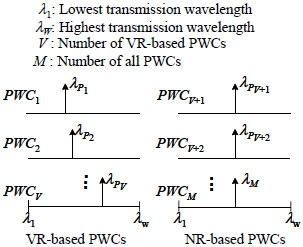
Fig1. Pump wavelengths of PWCs for HPA
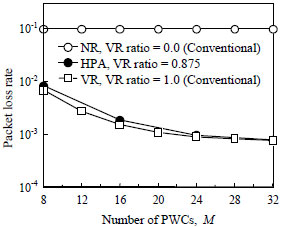
Fig2. Packet loss rate of HPA under different M.
Biography: Nattapong Kitsuwan received the B.E. and M.E. degree in Electrical Engineering (Telecommunication) from Mahanakorn University of Technology, King Mongkut's institute of Technology, Ladkrabang, Thailand, and a Ph.d. in Information and Communication Engineering from the University of Electro-Communications, Japan, in 2000, 2004, and 2011 respectively. From 2002 to 2003, he was an exchange student at the University of Electro-Communications, Tokyo Japan where he did research about optical packet switching. From 2003 to 2005, he was working for ROHM Integrated Semiconductor, Thailand, as an Information System Expert. His research focuses on optical networks, optical burst switching, optical packet switching, and scheduling algorithms.
 With the advance of the ubiquitous society by shift to IPv6, it is expected that various devices such as cars, home electronics, sensors, tags, and so on will be allocated IP address and connected to the network environment. On the other hand, Cloud computing is attracting the world. Cloud computing, via Internet, provides computation, software, data access, and storage services that do not require end-user knowledge.
With the advance of the ubiquitous society by shift to IPv6, it is expected that various devices such as cars, home electronics, sensors, tags, and so on will be allocated IP address and connected to the network environment. On the other hand, Cloud computing is attracting the world. Cloud computing, via Internet, provides computation, software, data access, and storage services that do not require end-user knowledge.
Then, we have been proposing IP based uGrid (ubiquitous Grid Networking Environment). In uGrid, everything connected to the network is defined as "Service-Part" and assigned IP address. Service-Parts mean not only devices but also software programs and data functions which are virtually "things". Users can use Service-Parts all over the world. Moreover, by combining various Service-Parts via network, uGrid can provide new mash-up services. Fig. 1 shows a concept of IP based uGrid. By connecting several IP addresses, the mash-up service of Service-Parts is realized. Because uGrid manages Service-Parts and executes uGrid service provisioning based on IP address, we utilize the IP mechanism such as routing, signaling, and DNS. The merit of utilizing IP mechanism is that, IP is an originally scalable mechanism, and many sophisticated technologies accumulated for years are available.
As a technology to manage Service-Parts with IP addresses, GMPLS is applicable. GMPLS is a suite of protocols which allows automate the provisioning and management of the network. Originally, GMPLS was proposed to generalize MPLS for packet switched network to other networks with different switching capabilities like TDM, lambda, fiber, and so on. Our motivation is to extend this "generalized" from switching capability (network, data link, and physical layer) to Service-Parts (application layer). In this research, extended routing protocol (Service-Routing) and extended signaling protocol (Service-Signaling) are proposed. Service-Routing searches Service-Parts and calculates the route for service mash-up. Service-Signaling executes reservation of Service-Parts resources and the establishment of the connection among Service-Parts. By experiment, it is shown that the combination of Service-Routing and Service-Signaling was succeeded.
This technology can realize next generation inter-Cloud which integrates the various Cloud such as SaaS, PaaS and HaaS/IaaS. By interconnecting various IP addresses of services via high-speed and high-capacity optical path, mash-up of service, as if executed in one server without considering the network distance, in cloud network can be realized.
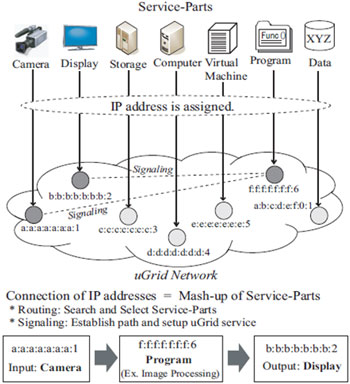
Fig1.
Acknowledgement: This work is supported by "R&D for Construction of Leading-edge Green Cloud Infrastructure (Environment-Related Network Signaling Technology)" project of Ministry of Internal Affairs and Communication (MIC) of Japan.
Biography: Kenta Nakahara was born in Tokyo, Japan on February 26, 1988. He received B.S degrees from Department of Information and Computer Science, Keio University Science and Technology, Tokyo, Japan, in 2010. Then he is admitted to The Center of Smart Media Communication Engineering, Graduate School of Keio University, Tokyo, Japan, in 2010. His current research interest is cloud networking system.
 Recent years, cloud computing which provides computational resources via Internet is attracting the world. Electricity consumption of data centers increases rapidly because the number of users of data centers increases with the growth of cloud computing. According to the world wide trend which urges growing out of dependence on fossil fuel and nuclear energy, it is hoped to consume electricity effectively and wisely. Then, we propose Live Data Center Migration, which can use electricity wisely because functions of data centers are transferred to other data centers geographically apart.
Recent years, cloud computing which provides computational resources via Internet is attracting the world. Electricity consumption of data centers increases rapidly because the number of users of data centers increases with the growth of cloud computing. According to the world wide trend which urges growing out of dependence on fossil fuel and nuclear energy, it is hoped to consume electricity effectively and wisely. Then, we propose Live Data Center Migration, which can use electricity wisely because functions of data centers are transferred to other data centers geographically apart.
For this proposal, we expand the live migration technology into wide area. This technology is originally used inside a data center, and able to transfer virtual machines from the server to another without stopping processes of the virtual machines. Fig. 1 shows the basic concept of our proposal network. The networks among the data centers are set up over the NGL2 (New Generation Layer 2) network with GMPLS (Generalized Multi-Protocol Label Switching) before the virtual machines migration. During the live migration, the memory images of the virtual machines are transferred via this network. The routes between users and data centers have to be switched smoothly after the virtual machine migration. There are two methods to solve this problem. The first is that, packets arrived at DAT (Dynamic Address Translation) are encapsulated with the header addressed to the data center, and transferred via Internet. The route can be switched due to changing the destination address of capsulation header. The other is that, packets arrived at NGL2 switch are added VLAN (Virtual LAN) tags, and transferred via the NGL2 network. It is necessary to set up VLAN path between users and data centers in advance and the route can be switched due to changing VLAN tag.
The proposed system is implemented as shown in Fig.2. In this presentation, we mainly discuss the protocol of how to set up the networks among data centers and how to switch the routes between users and data centers.
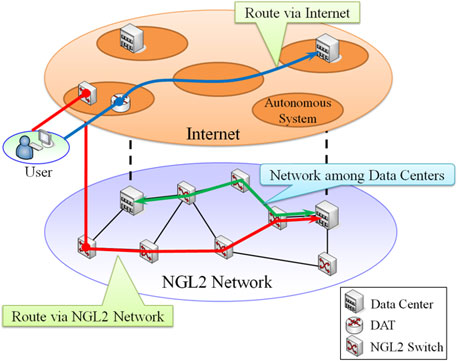
Fig1. The concept of proposal network.
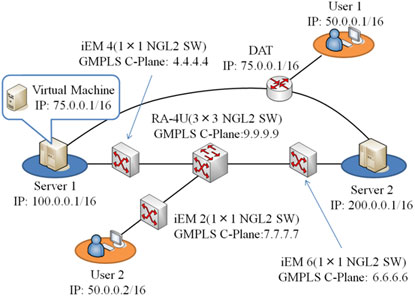
Fig2. An experimental system.
Biography: Haruki Takahashi was born in Kanagawa, Japan on March 5, 1987. He received B.S. degree from Department of Information and Computer Science, Keio University Science and Technology, Tokyo, Japan, in 2010. Currently, he is second-year master's degree student at The Center for Smart Media Communication Engineering, Keio University. He engages in research on cloud computing, new generation layer 2 wide area network and data center network.
 This presentation describes a scheme based on Round-Trip Time (RTT)
measurement to estimate link utilization. In the proposed scheme, two RTTs
are measured from a source host to both end nodes of a targeted link to obtain
their probability distribution functions; the bandwidth used by the probe pack-
ets is much smaller than that available. The link utilization rate is estimated
by deconvoluting the measured RTT values. Numerical results show that the
proposed scheme estimates link utilization accurately without affecting existing
traffic.
This presentation describes a scheme based on Round-Trip Time (RTT)
measurement to estimate link utilization. In the proposed scheme, two RTTs
are measured from a source host to both end nodes of a targeted link to obtain
their probability distribution functions; the bandwidth used by the probe pack-
ets is much smaller than that available. The link utilization rate is estimated
by deconvoluting the measured RTT values. Numerical results show that the
proposed scheme estimates link utilization accurately without affecting existing
traffic.

Fig1. Various RTTs on the path.
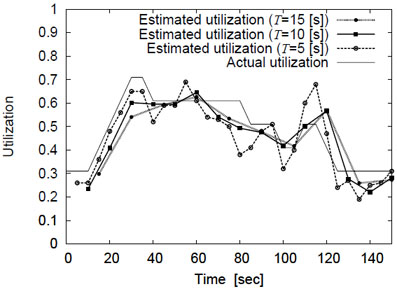
Fig2. Proposal follows changes in link utilization in step traffic pattern.
Biography:
- Current Affiliation : Master's student, Department of Communication Engineering and Informatics, Graduate School of Informatics and Engineering, The University of Electro-Communications, Tokyo, Japan
- Educational History : B. E. of Degree in Information and Communication Engineering (awarded 2011).
- Academic Society Membership : Student member of Institute of Electronics, Information and Communication Engineering (IEICE).
Friday 3, June 2011

[Discussed items]
- OTN
- Ethernet
- MPLS-TP
(- ASON)
Biography: Research Engineer, First Promotion Project, Network Service Systems Laboratories. He joined NTT Network Service Systems Laboratories in 2000. Since 2000 he has been engaging in research and development of optical transmission systems, such as SDH, WDM, OXC and so on. Since 2003, he has actively participated in ITU-T SG15 on SDH, OTN, ASON, synchronization and packet transport technology. Since 2009,he has also been participating in IETF. He is currently a Rapporteur for Question 3/15 (General characteristics of optical transport networks) of ITU-T SG15. He is a member of the Institute of Electronics, Information and Communication Engineers (IEICE) of Japan.
 This presentation will explore the potential development path to beyond 100G transport by considering the historical commercial
deployment timeline for 10-40-100G, the adoption criteria and strategies by application/segment, anticipated requirements and
performance tradeoffs for 100G+, as well as lessons from OIF's experience and approaches in the evolution to 100G.
This presentation will explore the potential development path to beyond 100G transport by considering the historical commercial
deployment timeline for 10-40-100G, the adoption criteria and strategies by application/segment, anticipated requirements and
performance tradeoffs for 100G+, as well as lessons from OIF's experience and approaches in the evolution to 100G.
Biography: Jonathan Sadler is a Senior Product Planner in the Optical Network Group at Tellabs. With over 20 years of data communications experience as a protocol implementer, network element designer, carrier network operations manager, and carrier network planner, Jonathan brings a broad set of knowledge and experiences to the design and analysis of carrier network technology. Currently, Jonathan is involved in the development of technologies providing the efficient transport of packet oriented services in Carrier Networks. Jonathan is the Chairman of the Optical Internetworking Forum's Technical Committee and an active participant in the IETF and ITU. Jonathan studied Computer Science at the University of Wisconsin - Madison.
 Many application vendors are trying to develop Cloud-aware Application with Cloud-APIs
based on REST/RESTful for SaaS, PaaS and IaaS. However, because Network vendors
don't yet provide nice APIs which are easy to develop the Apps, there are not so many
Application vendors who try to develop Network-aware application to control
GMPLS/MPLS/MPLS-TP path. Network-aware application can react changing network
condition dynamically and can help new network deployment. Nowadays Open-APIs are
demanding for accelerating Network-aware applications development.
Many application vendors are trying to develop Cloud-aware Application with Cloud-APIs
based on REST/RESTful for SaaS, PaaS and IaaS. However, because Network vendors
don't yet provide nice APIs which are easy to develop the Apps, there are not so many
Application vendors who try to develop Network-aware application to control
GMPLS/MPLS/MPLS-TP path. Network-aware application can react changing network
condition dynamically and can help new network deployment. Nowadays Open-APIs are
demanding for accelerating Network-aware applications development.
The paper discusses an architectural overview of the Network-aware Application for managing GMPLS/IP Optical path as follows and proposes REST/RESTful APIs to accelerate Network-aware application development for new network deployment such as Inter-cloud.
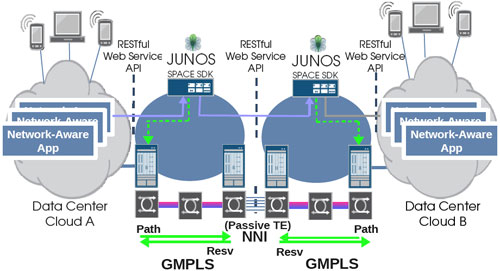
Fig1.
Biography: Hidetsugu Sugiyama is Director of R&D Support for Juniper Networks Asia Pacific based in Tokyo. He is responsible for developing technology partnership initiatives through Junos Developer Network Program in Asia Pacific and is focused on helping third-party developer partners for the software powered network development on the Junos Platform including Junos OS, Junos Space and Junos Pulse.
With over two decades in the information and communications technology industry, focusing on the networking and telecommunications sector, he has consistently demonstrated a desire to find and meet challenges of real world requirements and solutions. His current focus is the software powered network to support various innovative technologies such as IP Optical network plug & play, programmable switch, Inter-cloud technology and etc.
 Data Centers offer various application services to clients such as video games, cloud computing and others. Since the data centers used to provide application services are distributed geographically around a network, many decisions made in the control and management of application services, such as where to instantiate another service instance or to which data center out of several a new client is assigned, can have a significant impact on the state of the network. Conversely the capabilities and state of the network can have a major impact on application performance.
Data Centers offer various application services to clients such as video games, cloud computing and others. Since the data centers used to provide application services are distributed geographically around a network, many decisions made in the control and management of application services, such as where to instantiate another service instance or to which data center out of several a new client is assigned, can have a significant impact on the state of the network. Conversely the capabilities and state of the network can have a major impact on application performance.
The emerging trends in Data Center design has seen significant changes in data center network access approaches, e.g., from a drop off an optical metro ring (a wavelength or two), to an optical provider edge in a long haul DWDM system (many wavelengths, multiple fibers). This is partly due to the demand of high speed applications such as remote medical, live concert, sporting events and others, and partly due to the consolidation of existing Data Centers into Super Data Centers in carrier networks and the government IT infrastructure. These changes motivate more automated interactions between data center based applications and GMPLS controlled optical transport network, which we refer to as Application-aware Transport (ATN): Optical as a Service (OaaS), depicted in the below figure.
This paper presents the architecture of ATN-OaaS that enables:
- Cross application-network resource optimization
- Responsiveness to rapidly changing service demands
- Cross application-network service recovery
- Enhanced application quality of experience (QoE)
Key to providing this functionality are new "service" interfaces between the application and network that allow:
- Information sharing and feedback mechanism between application and network
- Abstraction mechanisms to promote the above sharing in a competitive environment
- The ability of application and network to make service requests of each other (e.g., reservation requests to the network from the application, or load shifting requests from network to application)
- Traceability of the application with respect to the network connection
In addition we review and compare this approach to other approaches including recent work on "Service Oriented Optical Networks".
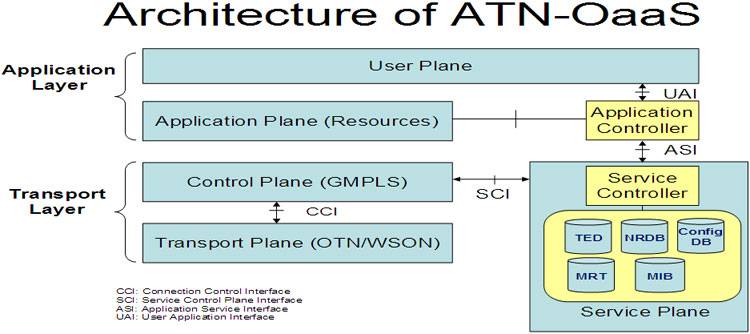
Fig1. Architecture of ATN-OaaS
Biography: Young is currently Principal Technologist at Advance Technology Division, Huawei Technologies USA Research Center, Plano, Texas. He is leading optical transport control plane technology research and development. His research interest includes cloud computing architecture, cross stratum optimization, distributed path computation architecture, multi-layer traffic engineering methodology, and network optimization modeling and new concept development in optical control plane signaling and routing.
Prior to joining to Huawei Technologies, Young was a co-founder and a Principal Architect at Ceterus Networks (2001-2005) where he developed topology discovery protocol and control plane architecture for optical transport core product. Prior to joining to Ceterus Networks, Young was Principal Technical Staff Member at AT&T/Bell Labs in Middletown/Holmdel, New Jersey. At AT&T Labs (1996-2000), he was responsible for core IP/MPLS network architecture evolution and AT&T End-to-end architecture planning. He also involved voice/data convergence architecture planning and evolution. At Bell Labs (1987-1995), Young was responsible for developing dynamic routing schemes and traffic network management control and measurement development. He is currently active in IETF PCE and CCAMP WGs and is a co-author of several RFCs. He holds several patents in the area of dynamic routing and switching technology and several patents pending in optical networking.
Young Lee received B.A. degree in Applied Mathematics from the University of California at Berkeley in 1986, M.S. degree in Operations Research from Stanford University, Stanford, CA, in 1987, and Ph.D. degree in Decision Sciences and Engineering Systems from Rensselaer Polytechnic Institute, Troy, NY, in 1996. He is a member of IEEE and Alpha Phi Mu honor society.
 Carriers are embracing a new network design philosophy of Packet switching over Optical switching. This new design is different than "all-packet" and "all-transport" network designs of the past as it allows "right-sized" switching of both fine grained flows and bulk transport. However, the control plane is now required to determine what path is the most efficient way to carry a service across the network.
Carriers are embracing a new network design philosophy of Packet switching over Optical switching. This new design is different than "all-packet" and "all-transport" network designs of the past as it allows "right-sized" switching of both fine grained flows and bulk transport. However, the control plane is now required to determine what path is the most efficient way to carry a service across the network.
This presentation will explore how control planes can be extended to support carrier policies defining a carrier's preferred way to carry a service. Technical dimensions including maximum latency allowed and availability required, as well as business dimensions including economic cost and opportunity foregone cost all need to be considered while maintaining the flexibility to specify policies on a per-carrier domain basis.
This presentation will propose a novel method that uses Multi-Layer Routing to perform path computation while considering carrier policies. This method allows for per-service flexibility allowing it to be used in carrier networks that support multiple different service definitions simultaneously.
Biography: Jonathan Sadler is a Senior Product Planner in the Optical Network Group at Tellabs. With over 20 years of data communications experience as a protocol implementer, network element designer, carrier network operations manager, and carrier network planner, Jonathan brings a broad set of knowledge and experiences to the design and analysis of carrier network technology. Currently, Jonathan is involved in the development of technologies providing the efficient transport of packet oriented services in Carrier Networks. Jonathan is the Chairman of the Optical Internetworking Forum's Technical Committee and an active participant in the IETF and ITU. Jonathan studied Computer Science at the University of Wisconsin - Madison.
 The Wavelength Switched Optical Network (WSON), with the intelligent control by Generalized
Multi-Protocol Label Switching (GMPLS), is widely regarded as a promising candidate for optical
core networks. However, although the control plane techniques and data plane equipments are
available and the providers look forward to the deployment, the GMPLS-enabled WSON has not
been deployed yet, and more important, most network carriers seem to lack confidence to
promote the commercial deployment of this solution in the optical backbone. The reasons
behind this situation are complicated. From the technical point of view, the lacking of control and
data plane interoperability among different vendors is one of the major concerns [1].
The Wavelength Switched Optical Network (WSON), with the intelligent control by Generalized
Multi-Protocol Label Switching (GMPLS), is widely regarded as a promising candidate for optical
core networks. However, although the control plane techniques and data plane equipments are
available and the providers look forward to the deployment, the GMPLS-enabled WSON has not
been deployed yet, and more important, most network carriers seem to lack confidence to
promote the commercial deployment of this solution in the optical backbone. The reasons
behind this situation are complicated. From the technical point of view, the lacking of control and
data plane interoperability among different vendors is one of the major concerns [1].
To this end, a multi-vendor interoperable experiment has been carried out to demonstrate a highly resilient WSON, as the experimental setup shown in the following figure. In this experiment, eleven optical nodes from four different vendors were constructed in a mesh network, which was controlled by a fully distributed GMPLS control plane with protocol extensions in both routing and signaling. The lightpath restoration, in the case of multiple failures and simultaneous failures was successfully demonstrated and quantitatively evaluated, as the results reported in [2-3].
Different from these previous works which focused on reporting the experimental results, in this presentation, we concentrate on the description of technical details. We summarize the problems we met, the issues we solved and then highlight the experiences we learned during this multi-vendor interoperable experiment. We believe the main point of this talk will be greatly beneficial for the potential industrial deployment of GMPLS-enabled WSON in the future.
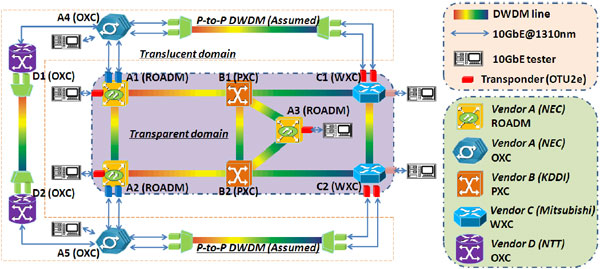
Fig1.
References:
- A. Farrel, "A unified control plane: dream or pipedream," IPOP 2010, K-3.
- I. Nishioka, et al, "Experimental demonstrations of dynamic wavelength path control and highly resilient recovery in heterogeneous optical WDM networks," OECC 2010, Postdeadline, PD1.
- S. Huang, et al, "Multi-failure restoration demonstration with multi-vendor interoperability in control plane enabled WSON," to appear in OFC/NFOEC 2011, NThC6.
Biography: Lei Liu was born in Liaoning, China, in 1981. He received the B.E. degree and the Ph.D. degree from Beijing University of Posts and Telecommunications (BUPT), Beijing, China, in 2004 and 2009 respectively. He is currently with KDDI R&D Laboratories Inc., Saitama, Japan. His research interests include the wavelength switched optical networks, network control and management techniques and Grid/cloud computing. He has published over 40 international journal and conference papers in the aforementioned research areas.
 Introduction:
The Wavelength Switched Optical Network (WSON), referring to Wavelength Division Multiplexing (WDM) based optical network in which switching is performed selectively based on the wavelength of an optical signal, is a promising optical network in that it provides broadband and energy-saving transmission. Recently, WSON-supported ROADMs and OXCs appear and interoperating experiments have been demonstrated [1]. On the other hand, there are few commercially-available routers working in WSON. In this presentation, we propose a GMPLS operation to interoperate WSON-unsupported nodes and WSON-supported ones. We call the operation "GMPLS-Light" in that WSON-unsupported nodes (ex. routers sending/receiving electrical signal) do not send GMPLS protocol messages related to WSON, while necessary message objects are exchanged and relayed among WSON-supported nodes (ex. ROADMs and OXCs). This paper explains requirements and solutions to realize interoperating WSON and non-WSON with GMPLS-Light.
Introduction:
The Wavelength Switched Optical Network (WSON), referring to Wavelength Division Multiplexing (WDM) based optical network in which switching is performed selectively based on the wavelength of an optical signal, is a promising optical network in that it provides broadband and energy-saving transmission. Recently, WSON-supported ROADMs and OXCs appear and interoperating experiments have been demonstrated [1]. On the other hand, there are few commercially-available routers working in WSON. In this presentation, we propose a GMPLS operation to interoperate WSON-unsupported nodes and WSON-supported ones. We call the operation "GMPLS-Light" in that WSON-unsupported nodes (ex. routers sending/receiving electrical signal) do not send GMPLS protocol messages related to WSON, while necessary message objects are exchanged and relayed among WSON-supported nodes (ex. ROADMs and OXCs). This paper explains requirements and solutions to realize interoperating WSON and non-WSON with GMPLS-Light.
Requirements: In order to interoperate WSON-unsupported routers and WSON-supported ROADMs and OXCs, there are several requirements; (1) routers need to have no impact on interoperate WSON nodes, (2) routers need to understand a network topology including a WSON, (3) routers need to control a routing to some extent, (4) routers need to neglect WSON-extended information in a routing protocol received, and (5) ROADMs and OXCs need to take WSON-extended objects from a signalling protocol before relaying them to routers.
Solutions: Fig.1 explains our proposed GMPLS operation "GMPLS-Light". In this network, routers don't support WSON and are outside WSON, while ROADMs are in WSON. Under the GMPLS-Light path set-up control, a source router computes a path route with constraint shortest path fast (CSPF). A border node of WSON computes an available wavelength and, if necessary, a route. Then, the border node adds wavelength information, which is used in WSON, to signaling message. The other border node of WSON takes the wavelength information from the signaling message and sends it to a node outside WSON. One of recommended GMPLS RSVP-TE signaling scenarios is as follows. Firstly, a source router R1 sends RSVP-TE signaling by assigning only R2 loosely as a path route and switching type as Label Switching Capable (LSC). Here, R1 is assumed to understand a topology in LSC region including all of the routers and ROADMs with OSPF-TE. When a ROADM O1 receives the signaling message from R1, its routing and wavelength algorithm (RWA) computes a route and one of available wavelengths, then sends the signaling which assigns explicit route object (ERO) and wavelength label to the next node.
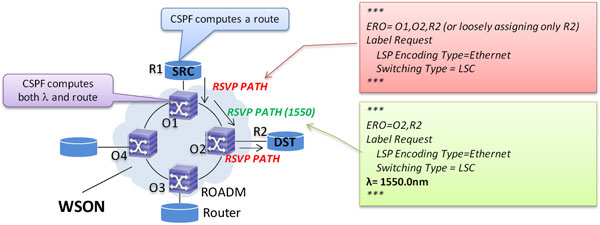
Fig1. An example of GMPLS signaling based on GMPLS-Light.
References:
- S. Huang, et al, "Multi-failure restoration demonstration with multi-vendor interoperability in control plane enabled WSON," to appear in OFC/NFOEC 2011, NThC6.
Biography: Rie Hayashi received the B.S. and M.S. degrees in Electronic Engineering from the University of Tokyo, Tokyo, Japan, in 2001 and 2003, respectively. In 2003, she joined NTT (Nippon Telegraph and Telephone Corp.) Network Service Systems Laboratories, where she has been engaging in research of multilayer traffic engineering techniques and flow-control methods. She is now researching control and management techniques for next-generation optical backbone network. She is a member of the IEICE.
 Every telecommunication operator has the important objective to provide satisfying
quality of service (QoS) to the final customer. Network restoration is a prime
capability to resist to the different threats causing network disruptions.
The most common network failures originate from construction activity: digging,
mining, drilling [1]... These failures have one thing in common, they are totally
unpredictable. It is impossible to know in advance when or where they will occur.
In this presentation we introduce a new method of proactive restoration. Basic idea is
to detect a risky event long before it actually occurs on the link using fiber itself like a
sensor and to trigger proactive restoration using the GMPLS protocol suite. In order to
detect premises of risky events and in a way to predict future outage of the optical link
we follow up states of polarization (SOP) changes in the case of various mechanical
movements applied on the fiber. We observe that different movements have different
signatures: Figs. 1 and 2 show changes of the polarization states due to a hit on the
fiber and swaying of the fiber. Reversely, similar mechanical movements applied on
the fiber show similar signatures. In order to automate the premise identification we
use an artificial intelligence tool called Khiops. Khiops is Orange Labs' scoring tool
for mining large databases [2].
Every telecommunication operator has the important objective to provide satisfying
quality of service (QoS) to the final customer. Network restoration is a prime
capability to resist to the different threats causing network disruptions.
The most common network failures originate from construction activity: digging,
mining, drilling [1]... These failures have one thing in common, they are totally
unpredictable. It is impossible to know in advance when or where they will occur.
In this presentation we introduce a new method of proactive restoration. Basic idea is
to detect a risky event long before it actually occurs on the link using fiber itself like a
sensor and to trigger proactive restoration using the GMPLS protocol suite. In order to
detect premises of risky events and in a way to predict future outage of the optical link
we follow up states of polarization (SOP) changes in the case of various mechanical
movements applied on the fiber. We observe that different movements have different
signatures: Figs. 1 and 2 show changes of the polarization states due to a hit on the
fiber and swaying of the fiber. Reversely, similar mechanical movements applied on
the fiber show similar signatures. In order to automate the premise identification we
use an artificial intelligence tool called Khiops. Khiops is Orange Labs' scoring tool
for mining large databases [2].
Based on this proactive identification of risky events, we propose to use the GMPLS control plane to trigger a proactive restoration while the traffic is still unobstructed on the data plane. Several mechanisms can be applied. For example, in order to inform the ingress node that it should re-route an existing lightpath, the receiving end-node that proactively detects the risky event can use the signaling protocol and send an RSVP-TE Notify message. Another option is to send this information to the IP layer and initiate a link graceful shutdown within the upper layer routing protocol. In this presentation we will show different possible solutions; we will discuss their drawbacks and advantages with respect to their complexity and potential network availability improvement.
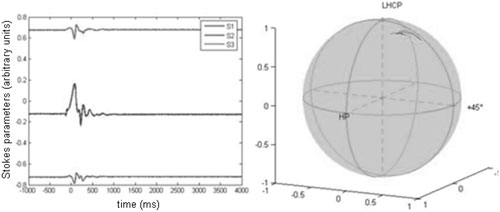
Fig1. Cartesian and Poincare sphere representations of Stokes parameters time evolution in a case of a hit on the fiber.
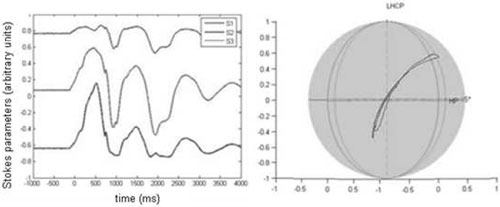
Fig2. Cartesian and Poincare sphere representations of Stokes parameters time evolution in a case of a swaying of the fiber.
References:
- M.Hoffman,"Cable Cuts" http://all.net/CID/Attack/papers/CableCuts.html
- http://www.khiops.com/
Biography: Julien Meuric is graduated from the French engineering school "Ecole Nationale Superieure des Sciences Appliquees et de Technologie". After various activities on packet networks, he has worked since 2004 in the Research and Development division of France Telecom, and more specifically on metropolitan and optical core networks. He is mainly focused on control plane integration in transmission networks, such as SDH or WDM, and interactions with packet layers. As a Standardisation Senior Manager he contributes to coordinate the standardisation of transport network technologies and is personally involved in standardisation around GMPLS control protocols in corresponding IETF working groups (CCAMP, L1VPN, MPLS...). Besides technical contributions, he also acts in IETF as co-chairman of the Path Computation Element (PCE) working group.
 Introduction:
In this abstract, four signaling approaches for the co-routed bidirectional lightpath provisioning in
GMPLS-based single-administrative WSONs are analyzed in order to investigate their fundamental
capability of distributed wavelength assignment. Here, we put our focus on the analysis of blocking
performance, as it is a core criterion for the future on-demand end-to-end lightpath service in the growing
WSON. Analysis from other perspectives such as flexibility, scalability etc., is out of the scope of this abstract.
Issues such as wavelength conversion, and other constraints like physical impairment and limited 3R
resource are out of the scope of this abstract.
Introduction:
In this abstract, four signaling approaches for the co-routed bidirectional lightpath provisioning in
GMPLS-based single-administrative WSONs are analyzed in order to investigate their fundamental
capability of distributed wavelength assignment. Here, we put our focus on the analysis of blocking
performance, as it is a core criterion for the future on-demand end-to-end lightpath service in the growing
WSON. Analysis from other perspectives such as flexibility, scalability etc., is out of the scope of this abstract.
Issues such as wavelength conversion, and other constraints like physical impairment and limited 3R
resource are out of the scope of this abstract.
Signaling Approaches and Features: The analysis is conducted under two scenarios: (i) the same wavelength is used for the both directions of a bidirectional lightpath according to the low-cost colored edge usage or management concern (ii) different wavelength can be employed for each direction when the ingress and egress are both the colorless edge. During signaling process, if no one common wavelength along the path is available in either direction, the request is blocked. The signaling approaches in analysis are listed as following:
- Upstream Label approach (UL) (RFC 3473) - In both the same and different wavelength use cases, UL is of the same blocking performance, as merely one wavelength label is conveyed in Upstream Label.
- Two unidirectional lightpaths approach (Two-Uni) - In the same wavelength use case, one direction must be set up firstly. Then the reserved wavelength needs to be specified for the inverse direction. In the different wavelength use case, two opposite unidirectional lightpaths are set up independently.
- Upstream Label Set approach (ULS) [1] - Upstream Label Set and Label Set objects are processed independently. In the same wavelength use case, upon receiving the two label set objects, egress selects a common available wavelength label from two label sets for both two directions. While, in the different wavelength use case, egress may select the available wavelength for each direction independently.
- Label Set approach (LS) [2] - Label Set object is employed to convey the common available wavelength labels in both directions. In the same wavelength use case, it is of the same performance of the ULS, but of lower than half amount of information in two Label Set objects used in ULS. It reduces the processing load in signaling. The different wavelength use case needs other supports.
Observations: Shown in Fig.1 and Fig.2 with setups of total wavelength number W=32, the length of path counted in hops H=2 and H=6 for two use cases, UL always has the poor performance due to the wavelength continuity constraint. Possible improvement by using other approaches is significant. The descriptions of the analysis models and further detailed results are omitted in this abstract.
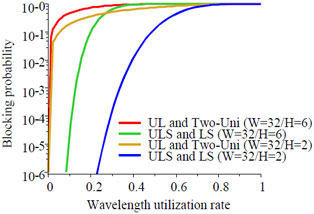
Fig1. Performance in same wavelength use case.
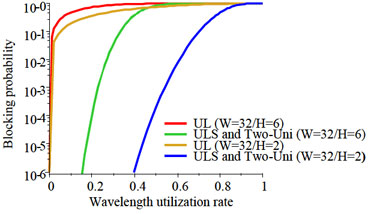
Fig2. Performance in different wavelengths use case.
References:
- E. Oki et al., "Bidirectional path setup scheme using on upstream label set in optical gmpls networks", IEICE Trans.Commun., vol.E87-B, no.6, pp.1569-1576, June 2004.
- G. Bernstein et al., "draft-ietf-ccamp-wson-signaling-00.txt"
Biography: Sugang Xu received his B.E. and M.E. degrees in computer engineering from Beijing Polytechnic University, Beijing, China, in 1994 and 1997, respectively, and Ph.D. degree in information and communication engineering at the University of Tokyo, Tokyo, Japan, in 2002. He joined the Global Information and Telecommunication Institute, Waseda University in 2002, as a research associate there. Since 2005, he joined National Institute of Information and Communications Technology (NICT), Tokyo, Japan, as an expert researcher. His research interests include algorithms, network architectures, photonic network control, optical grid network systems, parallel and distributed processing. He received the IEEE APB-APCC 2000 Best Paper Award in 2000, the IEICE Communications Society Conference English Section Best Paper Award in 2004. He is a member of the IEICE and IEEE.
 A method to mix impairments estimations and in-field measured data is proposed to evaluate the Quality of
Transmission (QoT) of new lightpaths in a GMPLS-controlled transludent optical network (a.k.a. WSON). The proposed
method is applied before lightpath establishment and increases the reliability of QoT estimation. We illustrate the
idea with a tutorial three step example.
A method to mix impairments estimations and in-field measured data is proposed to evaluate the Quality of
Transmission (QoT) of new lightpaths in a GMPLS-controlled transludent optical network (a.k.a. WSON). The proposed
method is applied before lightpath establishment and increases the reliability of QoT estimation. We illustrate the
idea with a tutorial three step example.
STEP I
A traffic demand requires wavelength connectivity from an ingress node A to
an egress node C. The feasibility of the selected path ABC is assessed, on a hop
by hop basis, using an estimation of the QoT based on static impairments data
which are retrieved from a database and processed by an off line tool.
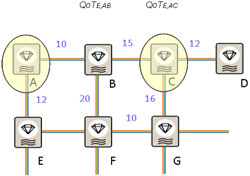
Fig1.
STEP II
A second traffic demand requires wavelength connectivity from an ingress
node A to an egress node D. A conventional PCE assesses the feasibility at each
intermediate and target nodes by estimation. The proposed ePCE takes into
account that a lightpath is already in place from node A to node C: the signal
quality in C can be measured, instead of being estimated.
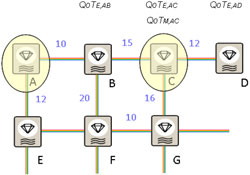
Fig2.
STEP III
The traffic demand from node A to node D is routed considering the measured
data in C and estimated data in B and D. As soon as the circuit from A to D is up
and running, its optical performances are sent to the ePCE, via PCEP, and can
be used to provide QoT measurements for further path calculation requests.
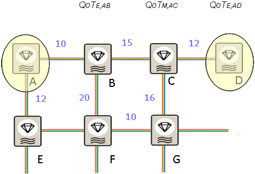
Fig3.
The performance of the proposed scheme has been applied to a demonstration WSON. Three cases have been considered using 10G NRZ or 40G RZ-DQPSK interfaces:
- PCE: where QoT is calculated only from estimated losses;
- ePCE: where knowledge from installed circuits is exploited (the "Learn Through Experience" method);
- BB: where a Big Brother possesses any measured information in advance (used as a benchmark).
Results hold in an average sense because they depend on the order of traffic population. When shorter connections are allocated first, ePCE may exploit them better and the result is closer to BB, otherwise it is closer to the usual PCE with no feedback from in-field measurements. Simulations indicates an average reduction of unnecessary regeneration of about 15~20% in the pan-European network scenario for 10G and 40G lightpaths.
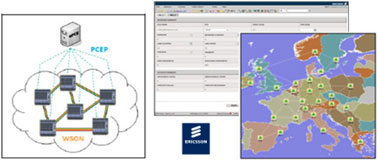
Fig4.
References:
- G.Bottari, D.Caviglia "Concurrent Impairments Aware Routing and Regenerator Location (PCE+) in a Wavelength Switched Optical Networks (WSON)"- IPOP09, Tokyo, Japan, June 11-12, 2009
- D.Caviglia, G.Bottari, F.Lazzeri, "Photonic Network Optimization via Resource and LSPs Concurrent Allocation: a PCE+ Concept", Proc. of OFC/NFOEC 2010, San Diego, CA, USA, March 21-25, 2010
- G. Bottari, D. Caviglia, "Twin Impairments Aware PCEs for WSON Networks", IPOP 2010, Tokyo, Japan, June 10-11, 2010.
Biography: Diego is working in the standardization arena since beginning of 2000, he's been active in IETF and OIF. He's co-author of several IETF Internet-Drafts and some RFCs, for the OIF he's been the technical contact point for OIF Interoperability events. Diego, with respect the standardization activity, is toady working on WSON and MPLS-TP topic.
Diego has been the technical lead for the Marconi/Ericsson GMSPL project today as Ericsson employee Diego has the responsibility as Product Manger GMPLS implementation in Ericsson Optical and Metro Product Line and planning tools
 ASON/GMPLS control plane, which can automate operations of path control, has been
deployed in service providers' commercial networks for bandwidth on demand services
[1], and its coverage area would be expanded for getting more OPEX reduction. To
control such larger networks, for example, the nation-wide thousands-node network, it
is required to divide the network into several domains, which means multi-domain
network, due to routing protocol convergence or administrative reasons. PCE-based
routing is suitable for multi-domain networks [2]. We have demonstrated PCE-based
routing incorporating with GMPLS protocol suites in multi-domain network, and have
shown that the path setup time increased with the number of domains and hop count
passed [3]. On the other hand, particular services like on-demand distributed cloud
expect shorter path setup time in order to optimize their system configuration rapidly
depending on resource usage. To reduce the path setup time, we have to accelerate
either route calculation, or signaling, or both.
ASON/GMPLS control plane, which can automate operations of path control, has been
deployed in service providers' commercial networks for bandwidth on demand services
[1], and its coverage area would be expanded for getting more OPEX reduction. To
control such larger networks, for example, the nation-wide thousands-node network, it
is required to divide the network into several domains, which means multi-domain
network, due to routing protocol convergence or administrative reasons. PCE-based
routing is suitable for multi-domain networks [2]. We have demonstrated PCE-based
routing incorporating with GMPLS protocol suites in multi-domain network, and have
shown that the path setup time increased with the number of domains and hop count
passed [3]. On the other hand, particular services like on-demand distributed cloud
expect shorter path setup time in order to optimize their system configuration rapidly
depending on resource usage. To reduce the path setup time, we have to accelerate
either route calculation, or signaling, or both.
In the presentation, we propose per-domain parallel signaling method to reduce the signaling time. It is not appropriate to improve routing method simply for reduction of the route calculation time because its time depends on the number of domains, which comes from polices about routing area planning or inter-domain access. On the other hand, we can reduce the signaling time by applying path stitching [4]. In fact, the experimental results show that the signaling time for inter-domain paths can be reduced to almost same time as that of intra-domain paths. We will report detail of our method and also show the experimental results not only for unprotected path but also end-to-end redundant path. Acknowledgement This work is a part of "Lambda Utility Project" supported by National Institute of Information and Communications Technology (NICT).
Acknowledgement: This work is a part of "Lambda Utility Project" supported by National Institute of Information and Communications Technology (NICT).
References:
- S. Liu and L. Chen, "Deployment of Carrier-Grade Bandwidth-on-Demand Services over Optical Transport Networks: A Verizon Experience", OFC/NFOEC 2007 NThC3, 2007.
- I. Nishioka, S. Ishida, Y. Iizawa, "End-to-End path routing with PCEs in multi-domain GMPLS networks", iPOP2008 T3-2, 2008.
- Y. Iizawa, I. Nishioka, S. Ishida, M. Nakama and S. Araki, "An Evaluation of Scalability of PCE-based Routing Model in Multi-Domain GMPLS Networks," iPOP2009, 6-2, 2008.
- A. Ayyangar, K. Kompella, JP. Vasseur and A. Farrel, "Label Switched Path Stitching with Generalized Multiprotocol Label Switching Traffic Engineering," RFC5150, 2008.
Biography: Yohei Iizawa received the B.S. and M.S. degrees in physics from Tohoku University, Sendai, Japan, in 2004 and 2006, respectively. In 2006, he joined System Platforms Research Laboratories, NEC Corporation, Kawasaki, Japan. His research interests include control architecture of optical networks.
 The multi-domain network scenario is expected to be a
fundamental part of new deployments, for an operator's network
may include several equipment vendors and segmenting
the network into domains is a means to increase the overall
scalability. When using Path Computation Elements (PCEs)
[1] for path computation, a cooperative mechanism known as
Backward Recursive Path Computation (BRPC) [2] can be
used, assuming that the domain sequence is known. For arbitrary
domain meshes, the domain selection may be delegated
to a higher-level entity (a parent PCE) using a collaborative
approach known as Hierarchical PCE (H-PCE). In this work,
we present the design, deployment and experimental validation
of an H-PCE architecture for path computation in multidomain
wavelength switched optical networks (WSON), using
a 2-level hierarchy combining a parent PCE with one child
PCE per domain (Fig. 1).
The multi-domain network scenario is expected to be a
fundamental part of new deployments, for an operator's network
may include several equipment vendors and segmenting
the network into domains is a means to increase the overall
scalability. When using Path Computation Elements (PCEs)
[1] for path computation, a cooperative mechanism known as
Backward Recursive Path Computation (BRPC) [2] can be
used, assuming that the domain sequence is known. For arbitrary
domain meshes, the domain selection may be delegated
to a higher-level entity (a parent PCE) using a collaborative
approach known as Hierarchical PCE (H-PCE). In this work,
we present the design, deployment and experimental validation
of an H-PCE architecture for path computation in multidomain
wavelength switched optical networks (WSON), using
a 2-level hierarchy combining a parent PCE with one child
PCE per domain (Fig. 1).
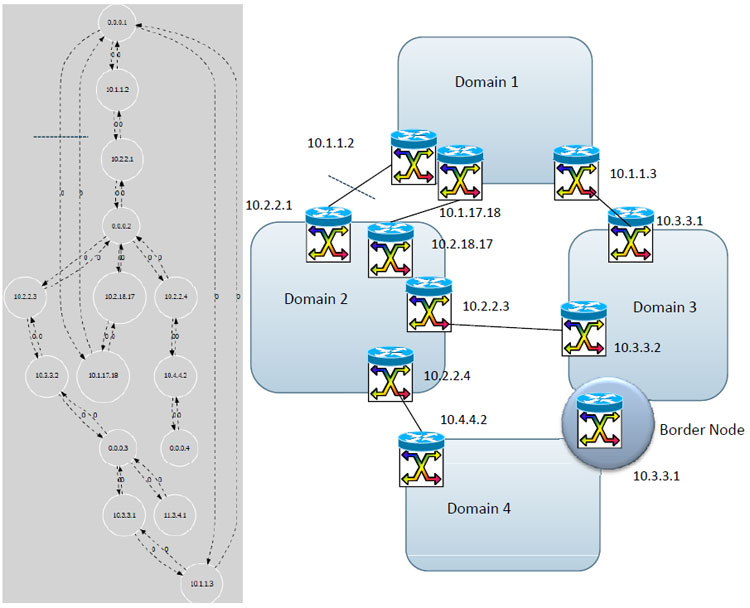
Fig1. Two-level H-PCE deployment model: child PCE per domain
Within this architecture, it is possible to define the functionalities of each level (e.g. LSP traffic engineering and domain sequence selection), including the case where the child PCEs are responsible for path computation within their domain and topology aggregation, which refers to the method by which a parent PCE obtains a (simplified) Traffic Engineering Database (TED) to operate on (Fig. 2). Such method defines how nodes and links representing a domain are synthesized in order to reduce the number of topology elements, allowing the architecture to scale with a large number of domains. Such an aggregation should focus not only on basic TE attributes in terms of bandwidth, but also in terms of SRLGs and additional restrictions such as wavelength continuity in transparent optical networks.
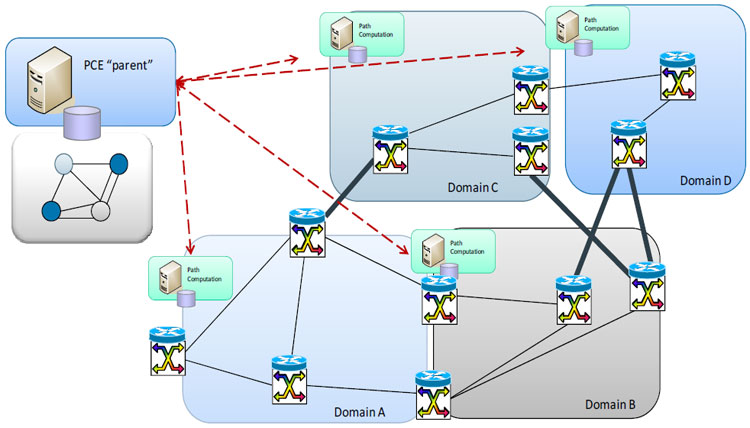
Fig2. Parent sample abstracted topology
In particular, we detail the proposed PCEP [3] protocol extensions [4], covering reachability dissemination, aggregated announcements of synthesized topology elements and the extended path computation procedures (e.g. Fig. 3) in the scope of the hierarchical computation. We finish with our deployment experiences with two scenarios: a domain represented as a star-hub topology and a domain represented as a mesh of virtual links between border nodes, evaluating the performance with aspects such as path computation latency and/or volume of control information.
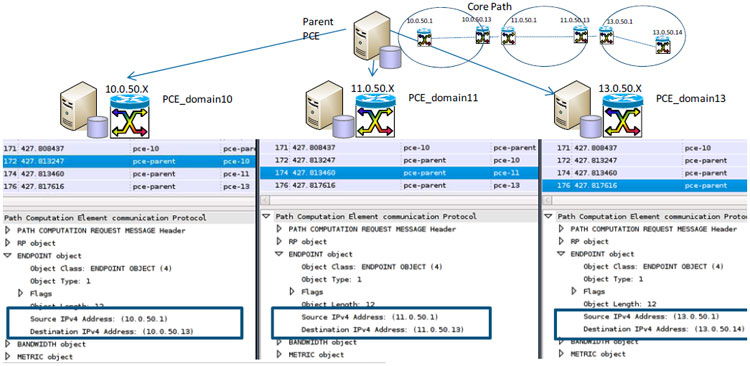
Fig3. PCEP protocol extensions and procedures in support of H-PCE ACKNOWLEDGMENT
Work partially funded by the MICINN (Spanish Ministry of Science and Innovation) through the project DORADO (TEC2009- 07995), and by the the European Community's Seventh Framework Programme FP7/2007-2013 through the Integrated Project (IP) STRONGEST under grant agreement no 247674
References:
- A. Farrel et al. A Path Computation Element (PCE)-Based Architecture, RFC4655.
- J.P. Vasseur et al. BRPC Procedure to Compute Shortest Constrained Inter-Domain Traffic Engineering LSPs, RFC5441.
- J.P. Vasseur et al. Path Computation Element (PCE) Communication Protocol (PCEP), RFC5440.
- F. Zhang et al, Extensions to PCEP for Hierarchical Path Computation Elements (PCE) I.-D. draft-zhang-pcep-hierarchy-extensions, WIP.
Biography: Ramon Casellas (Barcelona, 1975) graduated in Telecommunications Engineering in 1999 both from Technical University of Catalonia (UPC, Barcelona, Spain) and from the Ecole Nationale Superieure des Telecommunications (ENST, Paris, France) in the framework of a double degree Erasmus grant program. After working as an undergraduate researcher at France Telecom R&D and at British Telecom Labs, he completed his Ph.D. in 2002 at the ENST Paris, where he worked as an associate professor at the Networks and Computer Science department. In 2006, he joined the Optical Networking Area of the Centre Tecnologic de Telecomunicacions de Catalunya (CTTC), holding a research associate position and acting as the coordinator of the ADRENALINE testbed. He has been involved in several public-funded European research projects, technology transfer activities and, recently, in IETF standardization. His research interests include the GMPLS and PCE architectures and protocols; traffic engineering mechanisms, and the performance evaluation and optimization of core networks.
 New generation optical networks will need to achieve large capacity, high energy efficiency, simple
control/management mechanism, and will also be required to provide high-quality services (e.g. high-definition
video transfer, remote surgery, etc) as well as best-effort services. We have been developing optical packet and
circuit integrated networks in which both packet- and circuit-switching methods can be provided on the same fiber
infrastructure [1][2]. Optical circuit-switching method occupies an end-to-end bandwidth, which is often called
optical path or lightpath, in order to provide high-quality services. Our optical integrated networks separate the
wavelength bandwidth into packet resources and lightpath resources, and dynamically move the boundary between
the two kinds of resources. This processing is called dynamic resource adjustment control by which the network can
flexibly/effectively utilize the wavelength resources depending on users' demands or the situation of network traffic.
Moreover, we successfully developed the world's first technology that transfers path control messages (e.g.
signaling, routing, etc) on optical packet-switched links [1], which can unify the control interfaces of both switching
methods and simplify control equipments/management.
In this talk, we propose and implement an autonomous distributed resource adjustment control for optical packet
and circuit integrated networks. Fig. 1 illustrates an example of the control, in which the number of wavelengths
in each waveband (i.e. packet-, shared- or path-waveband) is 8. The shared-waveband is used for either one of
packet and path at a time depending on users' demands for lightpath. If the shared-waveband is used for packet, the
lightpath resources contain 8 wavelengths(λ); If it is used for path, the lightpath resources contain 16λ. We
implemented a control function which can autonomously increase or decrease the lightpath resources depending on
the number of "in-use" lightpaths in each link at each node. Every time signaling messages are transferred for
lightpath establishment or release, each related node autonomously checks the status of wavelength usage at each of
input and output interfaces. Just after that, the resource adjustment is performed: In the current system, when a
lightpath is established, the lightpath resources increase from 8λ to 16λ if the number of in-use lightpaths reaches 7;
When a lightpath is released, the lightpath
resources decrease from 16λ to 8λ if the
number of in-use lightpaths is zero and less
than 7 within the shared-waveband and the
path-waveband, respectively [2]. We can
flexibly change the above condition to
autonomously adjust the resources. By
means of a routing protocol, the update of
lightpath resources is advertised among
nodes inside the same domain. Contrary to
the conventional centralized resource
adjustment function in [2], the proposed
autonomous distributed function can
completely eliminate the remote control and
reduce the amount of control messages
flowing on the network. Furthermore, as
long as lightpath establishment or release is
successfully completed, the proposed
function never experiences the matter that
resource adjustment fails due to packet
discard in the network: The proposed
resource adjustment control is more robust
than the conventional method.
New generation optical networks will need to achieve large capacity, high energy efficiency, simple
control/management mechanism, and will also be required to provide high-quality services (e.g. high-definition
video transfer, remote surgery, etc) as well as best-effort services. We have been developing optical packet and
circuit integrated networks in which both packet- and circuit-switching methods can be provided on the same fiber
infrastructure [1][2]. Optical circuit-switching method occupies an end-to-end bandwidth, which is often called
optical path or lightpath, in order to provide high-quality services. Our optical integrated networks separate the
wavelength bandwidth into packet resources and lightpath resources, and dynamically move the boundary between
the two kinds of resources. This processing is called dynamic resource adjustment control by which the network can
flexibly/effectively utilize the wavelength resources depending on users' demands or the situation of network traffic.
Moreover, we successfully developed the world's first technology that transfers path control messages (e.g.
signaling, routing, etc) on optical packet-switched links [1], which can unify the control interfaces of both switching
methods and simplify control equipments/management.
In this talk, we propose and implement an autonomous distributed resource adjustment control for optical packet
and circuit integrated networks. Fig. 1 illustrates an example of the control, in which the number of wavelengths
in each waveband (i.e. packet-, shared- or path-waveband) is 8. The shared-waveband is used for either one of
packet and path at a time depending on users' demands for lightpath. If the shared-waveband is used for packet, the
lightpath resources contain 8 wavelengths(λ); If it is used for path, the lightpath resources contain 16λ. We
implemented a control function which can autonomously increase or decrease the lightpath resources depending on
the number of "in-use" lightpaths in each link at each node. Every time signaling messages are transferred for
lightpath establishment or release, each related node autonomously checks the status of wavelength usage at each of
input and output interfaces. Just after that, the resource adjustment is performed: In the current system, when a
lightpath is established, the lightpath resources increase from 8λ to 16λ if the number of in-use lightpaths reaches 7;
When a lightpath is released, the lightpath
resources decrease from 16λ to 8λ if the
number of in-use lightpaths is zero and less
than 7 within the shared-waveband and the
path-waveband, respectively [2]. We can
flexibly change the above condition to
autonomously adjust the resources. By
means of a routing protocol, the update of
lightpath resources is advertised among
nodes inside the same domain. Contrary to
the conventional centralized resource
adjustment function in [2], the proposed
autonomous distributed function can
completely eliminate the remote control and
reduce the amount of control messages
flowing on the network. Furthermore, as
long as lightpath establishment or release is
successfully completed, the proposed
function never experiences the matter that
resource adjustment fails due to packet
discard in the network: The proposed
resource adjustment control is more robust
than the conventional method.
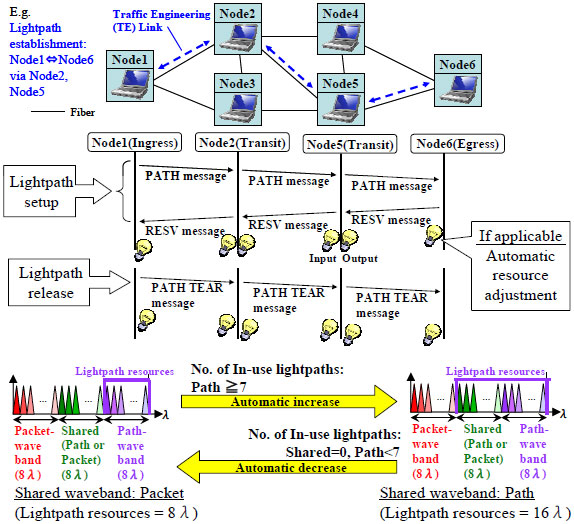
Fig1. An example of autonomous distributed resource adjustment
References:
- H. Furukawa, et al., 36th European Conference and Exhibition on Optical Communication (ECOC2010), We.8.A.4, September 2010.
- T. Miyazawa, et al., IEEE GLOBECOM 2010 Workshop on Network of the Future (FutureNet-III), pp.345-350, Miami, FL, USA, December 2010.
Biography: Takaya Miyazawa received his B.E., M.E. and Ph.D. degrees in Information and Computer Science from Keio University, Yokohama, Japan, in 2002, 2004 and 2006, respectively. From April 2006 to March 2007, he was a postdoctoral fellow at Keio University and also a visiting researcher at the University of California, Davis, USA. Since April 2007, he has been with the National Institute of Information and Communications Technology (NICT), Tokyo, Japan. He has been engaged in researches on optical network architecture. He is a recipient of the 2007 Hiroshi Ando Memorial Young Engineer Award and the 2010 Funai Young Researcher Award. He is a member of the IEEE and the IEICE.
 Optical Transport Network (OTN) is one of ITU-T standardization, established in 2001. Its interfaces are specified as G.709. In recent years, the discussion for its revision has been heated to support transporting Ethernet over OTN, especially 100Gbit/s Ethernet. The most important concept clearly defined in this new revision is the OTN technologies provide hierarchical multiplexing like SDH (Synchronous Digital Hierarchy). This means OTN-technology-based new networks will have ODU (Optical channel Data Unit)-based path switching capabilities, and they are enabled by OTN XC (cross-connect) equipments. Taking account this circumstances, we are investigating OTN XC architecture.
Optical Transport Network (OTN) is one of ITU-T standardization, established in 2001. Its interfaces are specified as G.709. In recent years, the discussion for its revision has been heated to support transporting Ethernet over OTN, especially 100Gbit/s Ethernet. The most important concept clearly defined in this new revision is the OTN technologies provide hierarchical multiplexing like SDH (Synchronous Digital Hierarchy). This means OTN-technology-based new networks will have ODU (Optical channel Data Unit)-based path switching capabilities, and they are enabled by OTN XC (cross-connect) equipments. Taking account this circumstances, we are investigating OTN XC architecture.
The key of the OTN XC architecture is switch fabric. The possible switch architectures are TDM (Time Domain Multiplexing)-based one and packet-based one. After comparison between them, we have decided to take TDM-based architecture from the view points of power consumption and latency. Detail will be shown the presentation.
When we take TDM-based switch architecture, we cannot take the same architecture that used in SDH XCs. This is because, the ODU frames for different bit rate have different durations, where SDH frames have single duration of 125 μsec. To solve this problem, we propose an architecture that uses unified internal frame (UIF) shown in Fig. 1. ODU frames, that have different durations and run independent clock, are converted to the UIFs, where all UIFs are operated with the same clock. Then the UIFs can be handled in TDM-based switch.
Fig. 2 shows proposed OTN XC architecture applying the UIF. Incoming ODU is converted to the UIF by the UIF mapper in front of the TDM-based switch. In the switch, a UIF is handled as a unit of switching. Each UIF is cross connected to adequate egress port of the switch and then ODU signal is restored at UIF de-mapper. The ODU signals are multiplexed into higher bitrate ODU frame (HO ODUk/OTUk) and then it is transported over the fiber.
We have built a POC (proof of the concept) of OTN XC. The system can accommodate up to 4 OTU2 (10.7Gbps) ports as network side interfaces, up to 2 SDH STM16 and 2 1000BASE-X as client side interfaces. The switch capacity is 100Gbps that is equivalent to 40 x 40 UIFs. The latency was measured on this system for STM16/ODU1 signals and the result was around 30 μsec. We've confirmed that OTN XC by TDM-based architecture can provide low latency characteristics.
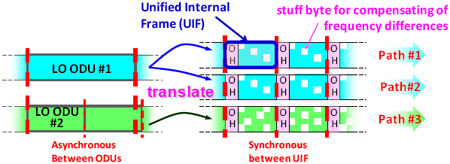
Fig1. Conceptual Drawing of UIF
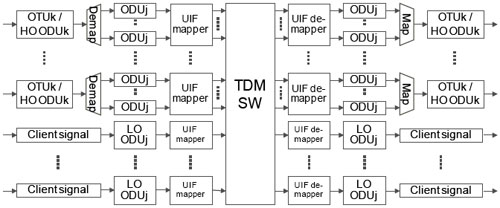
Fig2. Proposed OTN XC architecture
Biography: He received B.E. and M.E. degrees in electrical engineering from Yamanashi University, Yamanashi, Japan, in 1996 and 1998, respectively. He is a researcher at Network Products Business Unit, Fujitsu Ltd., Japan. He has been engaged in the development of optical transport system.
 This presentation reports our empirical consideration through interoperability tests with explanations of the time series transition and the latest updates on the MPLS-TP standardization.
This presentation reports our empirical consideration through interoperability tests with explanations of the time series transition and the latest updates on the MPLS-TP standardization.
Packet Transport based on MPLS-TP: MPLS-TP is a technology for constructing packet transport networks, which allow network carriers to deliver carrier-grade reliability, availability, and scalability. For this purpose, it introduces transport-grade Operation, Administration and Maintenance (OAM) features comparable to traditional SONET/SDH OAM. Besides, it boosts migration from legacy technologies by providing a capability to converge multiple legacy services with a unified packet transport network.
To fulfill network carrier's demands on packet transport, we have been delivering the AMN1700 series, which has been deployed by a large Japanese carrier to provide commercial services. The AMN1710 packet transport system used in the interoperability testing in terms of MPLS-TP.
Different OAM tool sets backed by two parties: In 2007, IETF and ITU-T established a joint working team to start standardization work of a packet transport technology as MPLS-TP. However, at this moment, there are two major OAM tool sets of OAM and resiliency mechanism, which are proposed by IETF and ITU-T respectively. IETF is proposing BFD-based OAM tool set, but ITU-T is also proposing Y.1731-based one. Consequently, those two OAM tool sets can not interwork each other, although they aim to provide similar features of fault management, performance monitoring, and resiliency mechanism.
Verification of the interoperability: Recently, MPLS-TP became one of the hottest test items in multivendor interoperability testing event conducted by independent test labs, ISCORE and EANTC. The interoperability test events offer beneficial opportunity for proving the interoperability of their MPLS-TP equipments according to the latest drafts for OAM tool sets. In contrast to most network equipment venders offering a single capability of either two OAM tool sets on their equipments, we have implemented both BFD-based and Y.1731-based OAM tool sets on our equipment and participated in interoperability tests for both of them. As a result, for instance, we could verify a defect detection capability of the BFD-based set has reached a technical maturity level comparable with the Y.1731-based one already.
Summary: Through the interoperability tests, we observed getting equivalent technical maturity level of both BFD-based and Y.1731-based OAM tool sets for packet transport network. Nevertheless, we see the BFD-based OAM tool set still having some remaining businesses on the protection protocol for resilience and use of IP/non-IP information as identifier. On the other hand, we suppose that a potential expandability of use of IP address as identifier could be discussed for interworking with conventional IP/MPLS routers in Y.1731-based OAM tool set.
Biography: Kiyotaka Takahashi is a researcher at Central Research Laboratory, Hitachi Ltd. He has been working on product development projects for packet transport equipments. He received a B.S degree in Information and Computer Sciences from Toyo University, Japan, in 1994, and withdrew from the Doctoral Program with the Completion of Course Requirements, the Graduate School of Information Science and Engineering, Tokyo Institute of Technology, Japan, in 2008.
 Recent trends in the industry indicate strong demand for management tools that automate
provisioning and validation of Ethernet services over transport networks. Point-and-click
functionality and the integration of simple validation via connectivity checks are key features
supported by such tools. A common approach is to perform these steps by using management
plane functionality. Such approach has limitations in terms of dynamicity, scalability and
interactions with other functionality in the network.
Recent trends in the industry indicate strong demand for management tools that automate
provisioning and validation of Ethernet services over transport networks. Point-and-click
functionality and the integration of simple validation via connectivity checks are key features
supported by such tools. A common approach is to perform these steps by using management
plane functionality. Such approach has limitations in terms of dynamicity, scalability and
interactions with other functionality in the network.
We argue that a combined control and management plane approach to Ethernet service selfestablishment and validation over transport networks addresses better the dynamic aspects and provides more opportunities for an integrated service-centric management to the operator. Our work builds on recent developments at IETF in terms of control plane functionality, related in particular to the provisioning of MPLS-TP infrastructure and the support for Ethernet services. We also take into account results from ITU-T regarding Ethernet service activation.
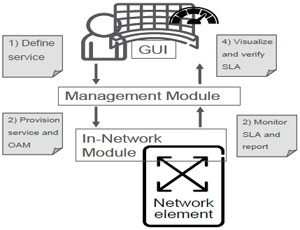
Fig1. Generic architecture for self-establishment and validation of Ethernet services in transport networks
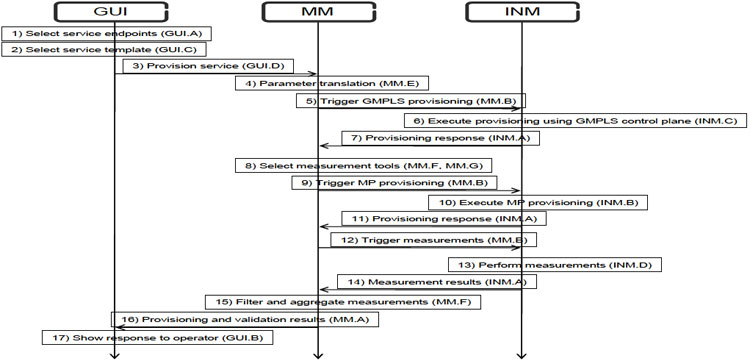
Fig2. Signaling diagram for one specific use case of the proposed system architecture.
Our proposal [1] is illustrated by the generic architecture presented in Fig. 1, as well as the signaling diagram shown in Fig. 2. The operator defines an Ethernet point-to-point connectivity service by specifying Metro Ethernet Forum-standard parameters on a high-level interface. Once the Management Module instantiates a service based on the description supplied by the operator, we show how the service may self-establish onto the network by triggering planning, provisioning and service validation steps automatically.
In addition to the proposal included in our recent paper [1], this presentation will contrast our solution which is based on control plane with a management plane-only alternative. We will also present additional details on the part of the Management Module related to the translation of service parameters into interactions with the network infrastructure. Finally, we will outline requirements for allowing higher-layer applications to interact with the provisioning and validation system.
References:
- A. Johnsson, C. Meirosu, N. Anjum, A. Tirdad. "Towards Automatic Provisioning and Validation of Ethernet Services over Transport Networks", IFIP/IEEE Distributed Autonomous Network Management Systems workshop, Dublin, May 27, 2011, accepted for publication.
Biography: Catalin Meirosu is a Senior Researcher with Ericsson Research in Stockholm, Sweden, where he is working on management for self-organizing networks, with focus on transport and packet networks. Prior to Ericsson, Catalin was a Project Development Officer with TERENA in Amsterdam and a project associate at CERN, Geneva Switzerland. Catalin holds a BSc degree (1999) from Transilvania University in Brasov, Romania, an MSc (2000) and a PhD degree (2005) from Politehnica University, Bucharest, Romania. Catalin performed his PhD research at CERN, Geneva, Switzerland, while working on the data acquisition system for the ATLAS experiment at the Large Hadron Collider. Catalin co-authored more than twenty scientific papers to date. He has several patent applications pending related to his work at Ericsson. He worked in several EU-funded research projects while at Ericsson, TERENA and CERN.